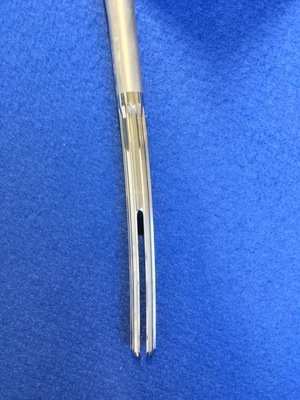CASE 19: Complex primary hip replacement for severe (Crowe Grade 4) hip dysplasia in a mid-life woman
The Story
“This 53-year-old woman had developmental dysplasia of the right hip (grade 4) with osteoarthritis.
She was experiencing severe pain and restriction of mobility as a result of the deformity.”
The Investigation
Pre-operative radiographs explored the current situation.
The Evidence
Anteroposterior plain radiograph shows developmental dysplasia of the right hip with a high hip centre.
Long leg radiograph to allow the surgeon to determine the best method to attain a more symmetrical leg length. In this case the hip centre needs to be brought equal to the other side, and will be achieved by use of a shortening femoral osteotomy.
The Diagnosis
This patient was diagnosed with developmental dysplasia of the right hip causing a leg length discrepancy.
The Plan
S-ROM - Long Modular Stem:
Image 1 (Trial components of S-ROM) This is a long modular stem, with the ability to vary the sleeve, stem length, proximal body type and head. This gives 10,398 combinations to suit the individual patient anatomy.
Image 2 (Final implant) The distal segment is fluted, providing stability in the distal bone.
Image 3 (close-up of fluted distal segment).
Shortening Femoral Osteotomy:
This graphic demonstrates the shortening femoral osteotomy. This is required for two reasons – to establish equal leg length, and to take the stretch of the sciatic nerve which can only tolerate up to 2 inches of stretch in these operations.
The Outcome
Post-operative radiograph shows satisfactory positioning of the implant. The cables help fix the osteotomy in place so that the bone heals.
The Verdict
“The patient’s leg length discrepancy was equalised without stretching the sciatic nerve. She has a good post-operative function.
When a decision is made to bring the hip centre back to its anatomical position, the femur often needs shortening in order to equalize leg length and take the stretch of the sciatic nerve.”









